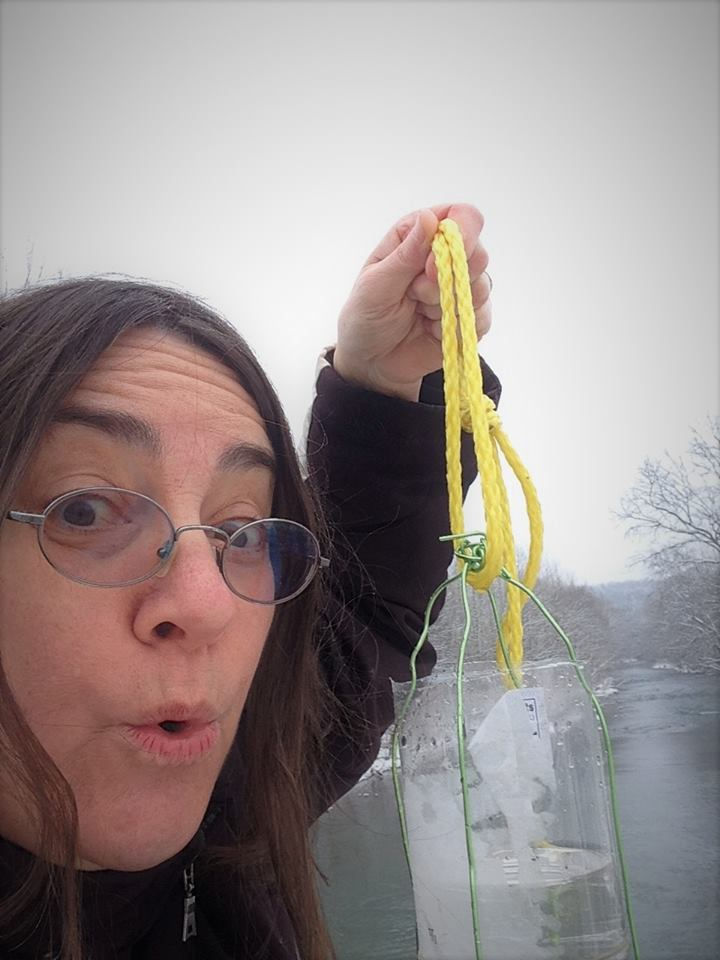Chloride Monitoring of
Deicing Salts in Middle River
Fast FAQs
Started: 2018-2019 only
Protocol Measures: Salt Runoff
Number of Volunteers that ran the Program: 11
Number of Sites Monitored: 10
Where is Data Sent?
Izaak Walton League of America

.

.

.

.
Summary of Results
Very little salt was measured in Middle River in the winter of 2018-2019.
The danger level for chloride at the time of the study was considered to be 230 parts per million.
The highest reading any of the volunteers got during our study was 49 parts per million. Because local levels were found to be so low, FOMR does not intend to continue salt monitoring on a routine basis.

Over the winter of 2018-2019, the Friends of the Middle River took water samples and tested for chloride to determine how salt used to melt ice in the winter was running off in snowmelt and rain events and getting into the river. Eleven volunteers monitored at 10 different sites along 30 miles of river, targeting downstream of several bridges, including the Interstate 81 bridge that crosses Middle River. Results of this pilot project indicate that very little salt was measured in Middle River under the 2018-2019 winter weather conditions.
The team made over 100 measurements using chloride test strips for the six largest salt/ice/snow weather events of the 2018-2019 winter season. In nearly every case, chloride was measurable in the river, but at the lowest levels. The danger level of chloride is considered to be 230 parts chloride per million parts of water, averaged over four days. The highest reading at any point on Middle River was 42 parts per million which occurred just downstream of the I-81 bridge. One point on Christian’s Creek got a reading of 49 parts per million. FOMR used a monitoring protocol developed by the Izaak Walton League of America.
The FOMR team had hypothesized that salt levels would increase throughout the winter as salt was repeatedly applied to roads, or that salt levels would increase further downstream compared to upstream as an effect of accumulation from many points of input.
Larger metropolitan areas have had more problems with runoff of road salts and some communities are developing a Salt Management Strategy to implement Total Maximum Daily Loads (TMDLs) set by the Department of Environmental Quality (DEQ) in areas of northern Virginia.
Because local levels were found to be so low, FOMR does not intend to continue monitoring, though we may take periodic readings in the future to make sure nothing is changing.
The graph below shows the data collected during the 2018-2019 winter season at each site, indicated by mile marker (MM).

How Did We Take Salt Readings?
1) FOMR used a sampling protocol developed by the Izaak Walton League of America in their SaltWatch program.
2) After a snow event that triggered deicing salts to be applied to the roads, volunteers collected a one inch sample of river water in a clean container, often on the downstream side of a bridge crossing Middle River.
3) The monitor added a chloride strip to the container and waited about five minutes for the chloride to soak up into the test strip.
4) The monitor read the mark of the white chloride line on the chloride strip and compared that against an interpretation card provided by The Izaak Walton League of America.
5) The monitor calculated how many parts per million of chloride salt there was in the water sample.
6) The volunteers took water readings throughout the winter season before and after all road treating events done by the Virginia Department of Transportation (VDOT).
7) Data was submitted to the Izaak Walton League of America's SaltWatch program.


Since 2008, VDOT has started “pre-treatment brining” of roads which is a liquid spray of 23% salt. This effective method lowers the amount of salt used on winter roads. They are also changing the mechanism of salt spreaders so that when a truck slows down or stops, the spreader decreases the amount of salt put down. The goal of this is to reduce the unnecessary piles of excess salt that get laid at intersections.
FOMR Member, volunteer and environmental contributer to the Staunton News Leader, Bruce Dorries wrote a special for the newspaper which you can read HERE.
~ Kate Guenther, Watershed Administrator
